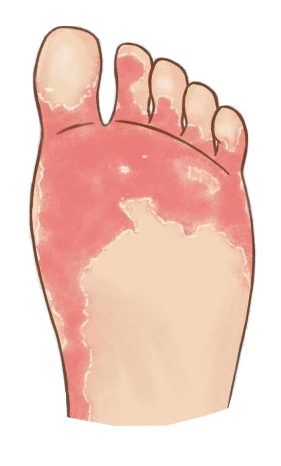What is Athlete’s Foot?
Athlete’s foot is a contagious fungal infection. Typically it starts between the toes. The condition is common in individuals whose feet often sweat while in tight-fitting shoes. Although, it can spread to the hands and toenails. This condition is extremely common in athletes. Nonetheless, athletes are not the only ones who experience it.
The condition of athlete’s foot is usually not serious. Though it is hard to cure. Therefore, it should be treated by a medical professional to ensure no re-occurrence. Although, if you suspect this condition and have diabetes, call a doctor immediately. Diabetics can experience serious complications.
Causes of Athlete’s Foot
Athlete’s foot occurs when the tinea fungus grows on the feet. You must be careful not to spread this condition. Direct contact with an infected person could be contaminated with the fungus.
This fungus lives in moist, warm environments. The fungus is commonly spread in showers and locker rooms. However, it can also be found around swimming pools.
Athletes foot is most common in athletes. However, anyone can get it. Although, certain behaviors do increase your risk. Below you will find risk factors for athlete’s foot:
- Being in public areas barefoot. This is especially true in showers, locker rooms, and swimming pools
- Sweaty feet
- Sharing shoes, socks, or towels with someone infected
- Not drying off your feet
- Wearing tight closed-toed shoes
- Minor nail injury on the foot
Athlete’s Foot Symptoms
- Cracking and peeling skin on the feet. Most commonly located between the toes and on your soles
- Itching, stinging, and burning between the toes or on soles of the feet
- Dry skin on the soles or sides of the feet
- Blisters on the feet that itch
- Raw skin on the feet
- Toenails that pull away from the nail bed
- Discolored, thick, and crumbly toenails
Treatment of Athlete’s Foot
Often, athletes foot can be treated over the counter. Although, sometimes prescription-strength is necessary. It is also common for your doctor to recommend soaking feet in saltwater. Some doctors recommend diluted vinegar to help dry up blisters.
Over the counter medications, such as:
- Miconazole (Desenex)
- Tolnaftate (Tinactin)
- Clotrimazole (Lotrimin AF)
- Terbinafine (Lamisil AT)
- Butenafine (Lotrimin Ultra)
Prescription medications, such as:
- Oral antibiotics: if bacterial infections develop due to raw skin and blisters
- Oral antifungal medications, such as itraconazole (Sporanox), fluconazole (Diflucan), or prescription-strength terbinafine (Lamisil)
- Topical, prescription-strength clotrimazole or miconazole
- Topical steroid medications to reduce painful inflammation
For a preferred Athletes Foot specialist in Broward or Palm Beach, call us today at 954-906-9272. Conveniently located in Boca Raton, Deerfield Beach, Coral Springs & Plantation.

